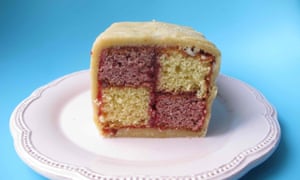
The battenberg cake, a gaudily coloured, peculiarly British confection, makes for an unlikely film star – unless the film is, of course, based on the work of that other peculiarly British creation, Alan Bennett, and then it seems as inevitable as the accompanying mug of stewed tea. Though the man himself is not “much drawn to” battenberg, its appearance is a convenient shorthand for a world rapidly vanishing in a puff of Yardley’s lavender.
Indeed, in his review of the The Lady in the Van, Mark Kermode fingered battenberg as “something which as far as I can tell exists only in Alan Bennett dramas …” – and was almost immediately hit by a barrage of outrage from fans of the pink and yellow chequerboard, also known as a church- or chapel-window cake, depending on affiliation.
Despite what is often claimed, these are unlikely to represent the four Battenberg princes, or to have been created to celebrate the marriage of one to our very own Princess Victoria – the food historian Ivan Day has satisfactorily dispelled this myth, while also revealing that early examples, which went by a variety of names, including a domino cake and a neapolitan roll, contained as many as 25 squares. Day suggests the simplification occurred when “large industrial bakers such as Lyons” got in on the battenberg game – “I suppose a four-panel battenburg [a common 19th-century spelling] is much easier to make on a production line”. Simpler, maybe, but they’re still much nicer made at home, and a delicious final resting place for marzipan still hanging around after Christmas.
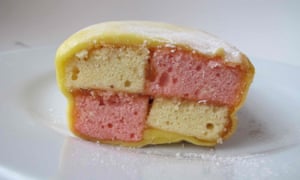
(I must apologise to some of the people mentioned, who are in no way responsible for the drunken appearance of their cakes – one of the most important things I learned this week was that battenberg assembly cannot be rushed. I promise they were judged on flavour and texture, rather than appearance.)
The cake
The cake itself is fairly non-contentious; classically, the battenberg is a pound, or genoise cake, made with equal weights of butter, sugar, flour and eggs, raised with baking powder. The only previous experience I have with battenberg is an hour’s tutelage in the kitchens of London’s Corinthia hotel some years ago with renowned pastry chef Claire Clark, who taught me the real meaning of that oft-repeated instruction: beat the butter and sugar together until pale and fluffy. Not for her a mere creaming together – the hotel’s giant mixer was working for at least five minutes, until the stuff in there looked more like overwhipped marge.
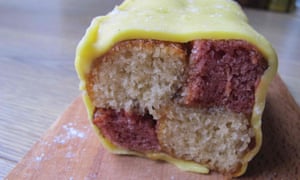
Getting enough air in is clearly important, which is part of the reason I think Mary Berry’s all-in-one method comes out tightly textured and rather flat. She replaces some of the flour with ground rice, which gives it a slightly sandy texture, whileLinda Collister’s Great British Bake Off Big Book of Baking goes for ground almonds. Although I love the flavour and moisture they give the cake, they do add weight to what should be a featherlight crumb.
Heston Blumenthal uses vegetable oil instead of butter, which makes his cakes so very moist they collapse after my cack-handed assembly – but also rather bland. This doesn’t matter in his case, because he’s chucking all sorts of other ingredients in there (of which more later), but a simpler recipe relies on all its component parts pulling their weight in the taste department. He also rests the batter overnight in the fridge, I suspect to allow the gluten to relax, but I don’t find those baked immediately have a problem with toughness, rendering this step unnecessary.
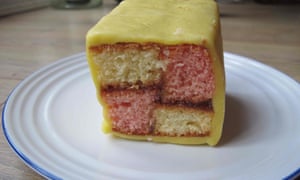
The flavourings
The earliest battenberg-type cakes were flavoured with almond essence, still the choice of Berry and Collister today, while Julie Duff keeps things plain in her book Cakes Regional & Traditional. I like the idea of a contrast between the flavour of the two cakes as well as the colour – to have them both tasting the same feels like a bit of a swizz.
Geraldene Holt goes for a delicate combination of vanilla and rose, both of which work well with the marzipan, and Blumenthal goes for camomile, his own fruit cup and freeze-dried berries. I’m not sold on the bitterness of the tea, but I do like the tang of the fruit in the pink one – and the fact that they tint the cake without the need for food colouring.
Collister adds chopped glace cherries to the pink cake, and chopped almonds to the yellow one, which gives them an interesting texture. I’m worried they will weigh the cakes down and stop them rising to the occasion, however, so I decide to redeploy the chopped almonds around the edge instead.
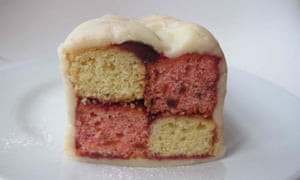
The baking
As a brief glance at my pictures will make clear, battenberg is a cake that requires patience and precision, neither of which appear in my top 10 qualities. Clark explains that when she was teaching at Le Cordon Bleu, it was her exam cake of choice for weeding out “the cooks from the perfectionists”. By those standards, I am definitely a cook.
The best way to ensure a neat-ish finish is to invest in a special tin, but, although I am now the proud owner of such an item, it’s probably not the best investment unless you’re batty about battenberg. Holt suggests dividing the tin with baking parchment, Clark some waxed card, and Blumenthal cooks them in two separate loaf tins, while Berry recommends baking them both together and then cutting them down the middle. As the cakes are likely to require trimming in any case, this seems by far the simplest option to me – although I must confess to also being motivated by a hatred of any faffing around with greaseproof paper.
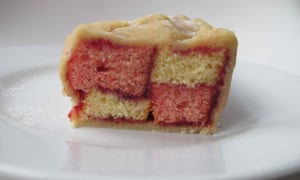
The jam
Traditionally apricot, although I prefer Duff’s raspberry with the almonds. Collister’s cherry also has its fans, but no one likes Blumenthal’s stridently bitter marmalade, or the camomile-flavoured sugar he sprinkles over it.
The marzipan
If you’re not simply looking for a way to use up the festive leftovers, this is a recipe it’s worth making a batch of marzipan for – it takes less than five minutes, and the flavour is infinitely superior.
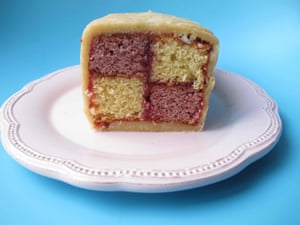
(makes 2 cakes or 1 large one)
175g slightly salted butter, at room temperature, plus extra to grease
175g caster sugar
20g freeze-dried raspberries (or use red food colouring if you prefer)
3 large eggs, beaten together
175g self-raising flour
Milk
A few drops of almond essence
75g blanched almonds
Raspberry jam, to coat
For the marzipan (or use 450g shop bought)
200g ground almonds
100g icing sugar, sifted
100g caster sugar
1 egg, separated
1 tbsp amaretto, brandy, whisky or lemon juice
Grease and base line a roughly 18 x 28cm tin. Heat the oven to 180C.
Beat together the butter and sugar until pale and voluminous – a good five minutes in a food mixer if you have one. Meanwhile, crush the raspberries, if using, to a powder and pass through a sieve.
Add the eggs, a little at a time, to the mixture, then gently fold in the flour, being careful to knock as little air out as possible, until it drops slowly from a spoon (add a little milk if it’s too thick). Divide the mixture in two, weighing each to make sure they’re even. Gently fold a few drops of almond essence into one, and the raspberry powder or food colouring into the other, plus a drop of milk to bring it back to the same dropping consistency.
Carefully spoon the uncoloured mixture into one half of the tin and level the top, then spoon the pink one into the other half and do the same. Bake for 25-30 minutes, until a skewer comes out clean, allow to cool for a couple of minutes then turn out on to a rack.
While the cakes are cooling, toast the blanched almonds in a dry pan, then coarsely chop. If making the marzipan, whisk the ground almonds and sugars together in a bowl and then stir in the egg yolk, followed by the amaretto and just enough egg white to make it into a smooth, dry paste, adding more almonds if it begins to feel sticky.
Cut the cakes apart, then trim the edges to neaten and cut into four equal strips. Cut these in half unless you particularly want one large cake, as they will be easier to work with. Roll the marzipan out on a clean, dry surface to a large rectangle about 3mm thick, then cut this in half. Warm the jam in a small pan.
Spread each piece of cake with jam on all sides, and sandwich together in alternating pairs. Roll in the almonds.
Roll the cakes up tightly in the marzipan, making sure there are no air pockets. Trim the ends to neaten.
Battenberg: best left to Alan Bennett, or a much underrated classic? Which other old-fashioned teatime treats deserve a revival? Personally, I’m throwing my considerable post-Christmas weight behind the seed cake and the garibaldi biscuit.
[“source-theguardian”]








